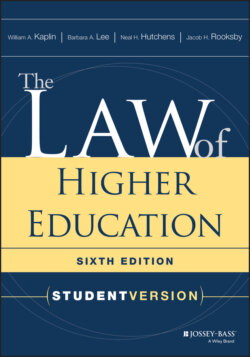Читать книгу The Law of Higher Education - William A. Kaplin - Страница 37
Section 1.5. The Public-Private Dichotomy
Оглавление
1.5.1 Overview. Historically, higher education has roots in both the public and the private sectors, although the strength of each one's influence has varied over time. Sometimes following and sometimes leading this historical development, the law has tended to support and reflect the fundamental dichotomy between public and private education.
A forerunner of the present university was the Christian seminary. Yale was an early example. Dartmouth began as a school to teach Christianity to the Native Americans. Similar schools sprang up throughout the American colonies. Though often established through private charitable trusts, they were also chartered by the colony, received some financial support from the colony, and were subject to its regulation. Thus, colonial colleges were often a mixture of public and private activity. The nineteenth century witnessed a gradual decline in governmental involvement with sectarian schools. As states began to establish their own institutions, the public-private dichotomy emerged. In recent years this dichotomy has again faded, as state and federal governments have provided larger amounts of financial support to private institutions, many of which are now secular.
Although private institutions have always been more expensive to attend than public institutions—tuition for public colleges, however, has also increased steadily in recent years to lessen the overall gap—private higher education has been a vital and influential force in American intellectual history. The private school can cater to special interests that a public one often cannot serve because of legal or political constraints. Private education thus draws strength from “the very possibility of doing something different than government can do, of creating an institution free to make choices government cannot—even seemingly arbitrary ones—without having to provide a justification that will be examined in a court of law” (H. Friendly, The Dartmouth College Case and the Public-Private Penumbra [Humanities Research Center, University of Texas, 1969], 30).
Though modern-day private institutions are not always free from examination “in a court of law,” the law often does treat public and private institutions differently. These differences underlie much of the discussion in this book. They are critically important in assessing the law's impact on the roles of particular institutions and the duties of their administrators.
Whereas public institutions are usually subject to the plenary authority of the government that creates them, the law protects private institutions from such extensive governmental control. Government can usually alter, enlarge, or completely abolish its public institutions (see Section 11.2.2 of this book); private institutions, however, can obtain their own perpetual charters of incorporation, and, since the famous Dartmouth College case (Trustees of Dartmouth College v. Woodward, 17 U.S. 518 (1819)), government has been prohibited from impairing such charters. In that case, the U.S. Supreme Court turned back New Hampshire's attempt to assume control of Dartmouth by finding that such action would violate the Constitution's contracts clause. Subsequently, in three other landmark cases—Meyer v. Nebraska, 262 U.S. 390 (1923); Pierce v. Society of Sisters, 268 U.S. 510 (1925); and Farrington v. Tokushige, 273 U.S. 284 (1927)—the Supreme Court used the due process clause to strike down unreasonable governmental interference with teaching and learning in private schools.
Nonetheless, government does retain substantial authority to regulate private education. But—whether for legal, political, or policy reasons—state governments usually regulate private institutions less than they regulate public institutions. The federal government, on the other hand, has tended to apply its regulations comparably to both public and private institutions, or, bowing to considerations of federalism, has regulated private institutions while leaving public institutions to the states.
In addition to these differences in regulatory patterns, the law makes a second and more pervasive distinction between public and private institutions: public institutions and their officers are fully subject to the constraints of the federal Constitution, whereas private institutions and their officers are not. Because the Constitution was designed to limit only the exercise of government power, it does not prohibit private individuals or corporations from impinging on such freedoms as free speech, equal protection, and due process. Thus, insofar as the federal Constitution is concerned, a private university can engage in private acts of discrimination, prohibit student protests, or expel a student without affording the procedural safeguards that a public university is constitutionally required to provide.
